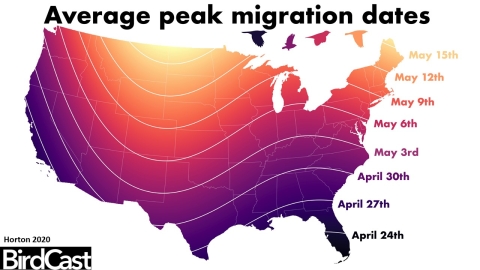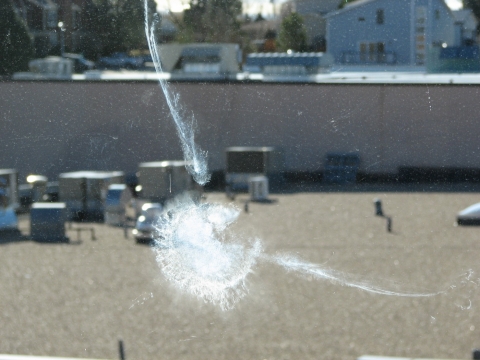In 2022, World Migratory Bird Day was celebrated on May 14 in the spring, and October 8 in the fall. The theme for the entire year is about reducing the impacts of light pollution on migratory birds and the significant threats it poses. The Migratory Bird Program is encouraging everyone to participate in reducing the impacts of light pollution and join in the international effort to "Dim the Lights for Birds at Night!"
Nighttime Lights and Birds: What’s the Issue?
Artificial light is scattered across the landscape of the entire country, and birds are frequently attracted to lighting, especially during inclement weather events during migration. Unfortunately, lights can cause confusion, disorientation, and exhaustion - directly impacting their ability to migrate.
For example, birds disoriented by lights can circle structures for extended periods of time, leading to exhaustion or accelerated use of energy stores critical for migration.
In addition, birds attracted to lights on buildings and structures frequently crash into windows and collide into buildings, unfortunately ending in tragedy.
Eliminating or reducing unnecessary lighting can reduce bird collisions, while simultaneously reducing energy demands and costs to building owners. Reducing nighttime lighting is especially important during peak bird migration periods, and periods of inclement weather.
What Can You Do?
1. Turn off your interior and exterior building lights during peak migration season!
We worked with our partners at the Cornell Lab of Ornithology’s BirdCast Program and the Colorado State University AeroEco Lab to help predict the most important timespan for spring bird migration and targeted our efforts from April 24-May 15, 2022. We do not have a targeted timeframe for fall migration as birds tend to migrate over a longer period of time and over a wider array of migration routes to their wintering grounds. The more nights you can turn off lights, the better!
Please use the map that Birdcast provided for the lower 48 states to help plan your activities for peak migration in your area. As we all know, Florida will have a different peak migration timeframe than Montana, so please use the map in your planning process! Of course, local weather events and other factors might impact the specific dates of peak bird migration, and you can take that into account during your decision-making process of when will work best for you to turn the lights off.
2. If you can’t turn off all lights, consider turning off exterior lights – the flood lights that face up into the sky, roof-top lights that illuminate the surrounding landscape, or change your motion sensors to only be active when people are present.
The International Dark Sky Association has more information and examples of the types of lighting structures you can use to reduce your light pollution.
Research has found that birds are particularly attracted to steady-burning red and white lights. Removing non-flashing/steady-burning lights can significantly reduce bird collisions with structures.
Reducing Bird Collisions
Every year more than a billion birds collide with glass in the U.S., and most of those fatalities happen at homes and buildings shorter than four stories tall. Even glass walkways and bus stop shelters cause bird collisions. Fortunately, even small efforts can make a BIG difference for birds!
Birds don’t see glass as a barrier so they don’t avoid it. They collide with glass when they see natural reflections (clouds, sky, or trees) in the glass, when they see plants through windows, and when they are attracted to landscaping or interior lights. Many birds that seem fine following window collisions can later die from internal injuries.
You can make your building safer for birds. Some bird safety measures even reduce your energy costs and look nice. You can help recover bird populations by preventing window collisions at your home and other buildings. Your small actions are hugely important for our birds…start making your difference today!
- Homeowners
- Building Managers and Tenants
- Low-cost Methods to Reduce Bird Collisions with Glass
- Methods to Reduce Bird Collisions with Glass When Remodeling and Designing New Facilities
For more information on reducing glass and lighting impacts and practical tips please visit Reducing Bird Collisions with Buildings and Building Glass.
Lights Out Partnerships through our Urban Bird Treaty Program
During migration, birds can fly off course toward brightly lit urban areas. At a time of year when all their energy needs to go to flying sometimes thousands of miles, these hazards can mean the difference between life or death. Many cities — major sources of the nighttime light pollution — are directly in migratory flyways and present unique hazards to migrating birds. Fortunately, many communities are taking action to reduce their impacts. There are over two dozen “lights out” programs in cities around the country, and many are part of the Urban Bird Treaty Cities network.
(Not) Lighting the Way for Birds
The 5 Myths about Light Pollution
Making New York City Safer for Birds: Project Safe Flight
What it Takes to Develop a Bird-Safe City
What the U.S. Fish and Wildlife Service is doing to "Dim the Lights for Birds at Night!"
Our Northeast Regional Office in Hadley, Massachusetts, reprogrammed their automatic lights, so they'll be "lights out" from 8pm-5:30am. This simple action is protecting birds in the area and saving electricity! They're getting the word out and hoping other businesses and organizations will follow suit.
The National Conservation Training Center in Shepherdstown, West Virginia, turned off their external lights and parking lights for World Migratory Bird Day. They also presented a virtual public lecture with Dr. Joelle Gehring on “Bird Collisions with Communication Towers: How We Can Reduce the Risks and Save Money.”
At the brand new Ankeny Hill Nature Center at Ankeny Hill National Wildlife Refuge in Oregon, our staff worked with the construction company to have the lights turn off each night, at the building and in the parking lot, and made sure there is a manual option for staff to use as well. This decision was made to help birds migrate and keep light pollution down.
Check back here to see more examples of what our facilities are doing!








